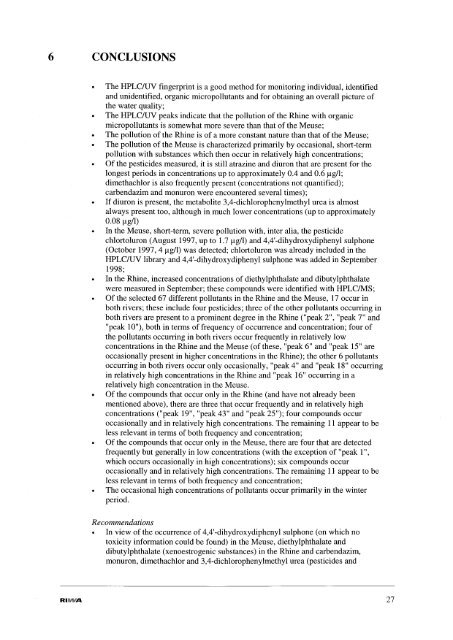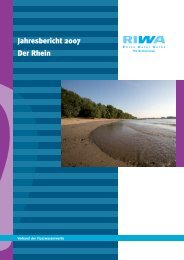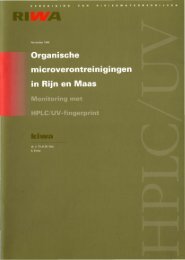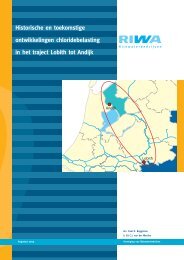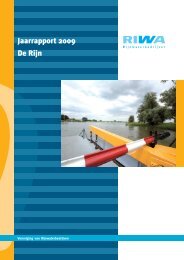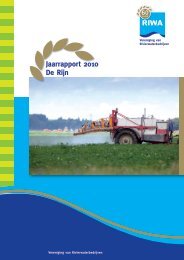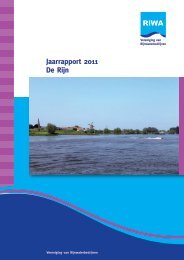Organic micropollutants in Rhine and Meuse a - Riwa
Organic micropollutants in Rhine and Meuse a - Riwa
Organic micropollutants in Rhine and Meuse a - Riwa
Create successful ePaper yourself
Turn your PDF publications into a flip-book with our unique Google optimized e-Paper software.
6<br />
CONCLUSIONS<br />
The HPLC/UV f<strong>in</strong>gerpr<strong>in</strong>t is a good method for monitor<strong>in</strong>g <strong>in</strong>dividual, identified<br />
<strong>and</strong> unidentified, organic <strong>micropollutants</strong> <strong>and</strong> for obta<strong>in</strong><strong>in</strong>g an overall picture of<br />
the water quality;<br />
The HPLC/UV peaks <strong>in</strong>dicate that the pollution of the Rh<strong>in</strong>e with organic<br />
<strong>micropollutants</strong> is somewhat more severe than that of the <strong>Meuse</strong>;<br />
The pollution of the Rh<strong>in</strong>e is of a more constant nature than that of the <strong>Meuse</strong>;<br />
• The pollution of the <strong>Meuse</strong> is characterized primarily by occasional, short-term<br />
pollution with substances which then occur <strong>in</strong> relatively high concentrations;<br />
Of the pesticides measured, it is still atraz<strong>in</strong>e <strong>and</strong> diuron that are present for the<br />
longest periods <strong>in</strong> concentrations up to approximately 0.4 <strong>and</strong> 0.6 Ilg/l;<br />
dimethachlor is also frequently present (concentrations not quantified);<br />
carbendazim <strong>and</strong> monuron were encountered several times);<br />
• If diuron is present, the metabolite 3,4-dichlorophenylmethyl urea is almost<br />
always present too, although <strong>in</strong> much lower concentrations (up to approximately<br />
0.08 Ilg/l)<br />
• In the <strong>Meuse</strong>, short-term, severe pollution with, <strong>in</strong>ter alia, the pesticide<br />
chlortoluron (August 1997, up to 1.7 Ilg/l) <strong>and</strong> 4,4'-dihydroxydiphenyl suIphone<br />
(October 1997,4 Ilg/l) was detected; chlortoluron was already <strong>in</strong>cluded <strong>in</strong> the<br />
HPLC/UV library <strong>and</strong> 4,4'-dihydroxydiphenyl sulphone was added <strong>in</strong> September<br />
1998;<br />
In the Rh<strong>in</strong>e, <strong>in</strong>creased concentrations of diethylphthalate <strong>and</strong> dibutylphthalate<br />
were measured <strong>in</strong> September; these compounds were identified with HPLCIMS;<br />
Of the selected 67 different pollutants <strong>in</strong> the Rh<strong>in</strong>e <strong>and</strong> the <strong>Meuse</strong>, 17 occur <strong>in</strong><br />
both rivers; these <strong>in</strong>clude four pesticides; three of the other pollutants occurr<strong>in</strong>g <strong>in</strong><br />
both rivers are present to a prom<strong>in</strong>ent degree <strong>in</strong> the Rh<strong>in</strong>e ("peak 2", "peak 7" <strong>and</strong><br />
"peak 10"), both <strong>in</strong> terms of frequency of occurrence <strong>and</strong> concentration; four of<br />
the pollutants occurr<strong>in</strong>g <strong>in</strong> both rivers occur frequently <strong>in</strong> relatively low<br />
concentrations <strong>in</strong> the Rh<strong>in</strong>e <strong>and</strong> the <strong>Meuse</strong> (of these, "peak 6" <strong>and</strong> "peak 15" are<br />
occasionally present <strong>in</strong> higher concentrations <strong>in</strong> the Rh<strong>in</strong>e); the other 6 pollutants<br />
occurr<strong>in</strong>g <strong>in</strong> both rivers occur only occasionally, "peak 4" <strong>and</strong> "peak 18" occurr<strong>in</strong>g<br />
<strong>in</strong> relatively high concentrations <strong>in</strong> the Rh<strong>in</strong>e <strong>and</strong> "peak 16" occurr<strong>in</strong>g <strong>in</strong> a<br />
relatively high concentration <strong>in</strong> the <strong>Meuse</strong>.<br />
• Of the compounds that occur only <strong>in</strong> the Rh<strong>in</strong>e (<strong>and</strong> have not already been<br />
mentioned above), there are three that occur frequently <strong>and</strong> <strong>in</strong> relatively high<br />
concentrations ("peak 19", "peak 43" <strong>and</strong> "peak 25"); four compounds occur<br />
occasionally <strong>and</strong> <strong>in</strong> relatively high concentrations. The rema<strong>in</strong><strong>in</strong>g 11 appear to be<br />
less relevant <strong>in</strong> terms of both frequency <strong>and</strong> concentration;<br />
Of the compounds that occur only <strong>in</strong> the <strong>Meuse</strong>, there are four that are detected<br />
frequently but generally <strong>in</strong> low concentrations (with the exception of "peak 1",<br />
which occurs occasionally <strong>in</strong> high concentrations); six compounds occur<br />
occasionally <strong>and</strong> <strong>in</strong> relatively high concentrations. The rema<strong>in</strong><strong>in</strong>g 11 appear to be<br />
less relevant <strong>in</strong> terms of both frequency <strong>and</strong> concentration;<br />
The occasional high concentrations of pollutants occur primarily <strong>in</strong> the w<strong>in</strong>ter<br />
period.<br />
Recommendations<br />
• In view of the occurrence of 4,4'-dihydroxydiphenyl sulphone (on which no<br />
toxicity <strong>in</strong>formation could be found) <strong>in</strong> the <strong>Meuse</strong>, diethylphthalate <strong>and</strong><br />
dibutylphthalate (xenoestrogenic substances) <strong>in</strong> the Rh<strong>in</strong>e <strong>and</strong> carbendazim,<br />
monuron, dimethachlor <strong>and</strong> 3,4-dichlorophenylmethyl urea (pesticides <strong>and</strong><br />
RIIIN'A<br />
27


